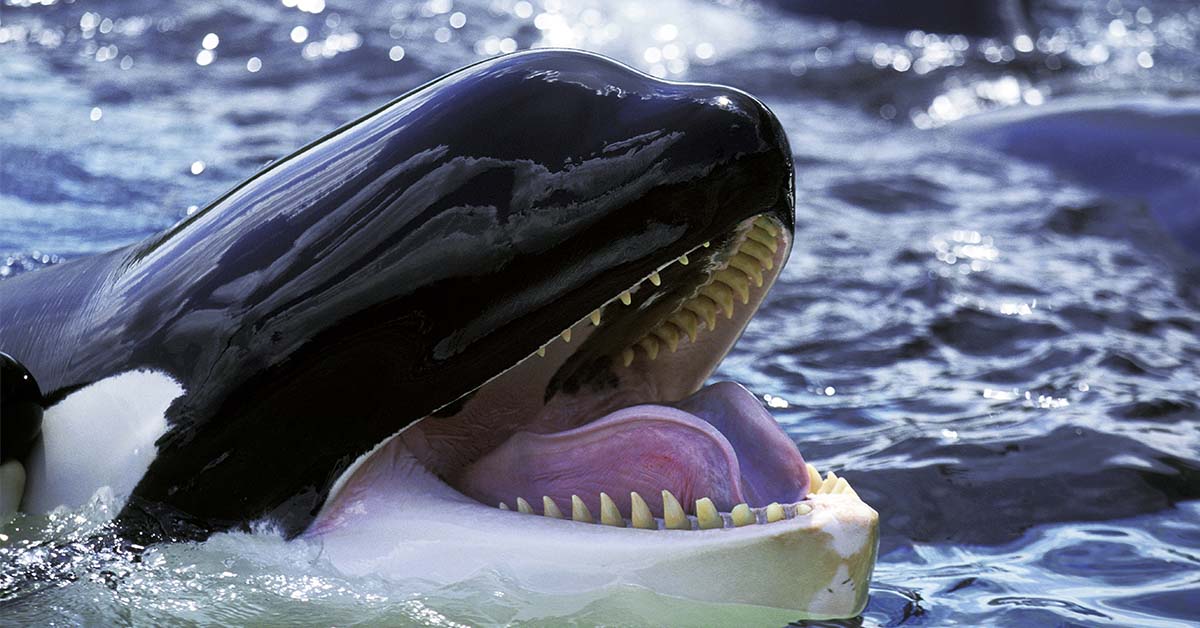SeaWorld is an American theme park well-known for its marine animal shows. However, it’s also well-known for orca attacks and controversies. In 2013, a documentary called Blackfish created negative press around the park and its animal treatment, leading to 2016, when SeaWorld announced the end of their in-park orca breeding program. Hopefully, this will mean the end of captive orcas attacking their trainers, a series that had continued since the 1970s. One noteworthy case took place in 1987, when an orca nearly drowned 26-year-old trainer Joanne Webber.
“I think my neck is broken!”
During a practice session, an orca leaped over Webber, landed on her “with the full force of 6,000 pounds, fracturing her neck, and thrusting her underwater to the bottom of a 40-foot-deep pool,” read her lawsuit. The orca was Kandu V, who became known for aggressive and erratic behavior. Webber was screaming, “I think my neck is broken,” as she tried to swim out of the pool. [1]
Webber had filed suit against SeaWorld, claiming her injuries were a result of negligence and fraud. She stated that the company knew the killer whales were “ferocious and dangerous” and “likely to attack and injure human beings,” while telling her the whales were “safe” and “gentle.” Additionally, the park’s personnel delayed Webber’s treatment, since they insisted she change out of her wetsuit so the medical staff won’t damage it once she reached the hospital. Unable to because of her painful injuries, the lawsuit says she was “stripped of (the) wetsuit by SeaWorld personnel”. Then they told her to dress and walk 200 yards to the ambulance. [2]
Her injuries included fractures of the first cervical vertebra, contusions of the skull and scalp, and bruises on her left arm and shoulder. Even a year later, two cracks in her neck vertebra hadn’t healed properly and she lost motion in her neck. The suit was settled out of court. But her story resurfaced in the face of SeaWorld’s newest controversy.
SeaWorld Orca Attacks Its Tankmate
Video footage captures the moment an orca at SeaWorld San Diego attacked another orca. It shows a killer whale beaching itself on a ledge while the other attacks it from underneath. Eyewitnesses noticed blood in the water as well as the wounds on the orca. Animal rights group PETA shared the clip, but SeaWorld called the video “misleading and mischaracterized.” The company claimed that this is common orca behavior and neither sustained any serious injuries.
Naomi Rose, a marine mammal scientist at the Animal Welfare Institute, notes that the orca beached itself since there was no other way to escape the attacks. In the wild, it could’ve just swam away. But while Rose doesn’t know why the orca attacked, she affirmed it was “most certainly” an act of aggression and not normal behavior. “…I will say that this kind of aggression in SeaWorld tanks is actually more common than SeaWorld lets on or tourist cameras capture.” [3]
The most famous case of an orca acting aggressively involves trainer Dawn Brancheau. She died on February 24, 2010, when an orca named Tilikum grabbed her hair and pulled her underwater. She drowned while suffering traumatic injuries. During the hearing against SeaWorld afterward, the attorneys for the federal Occupational Safety and Health Administration noted that Tilikum took part in another trainer’s death in 1991 in a park in British Columbia. [4]
Blackfish vs SeaWorld
Tilikum’s story was heavily featured in 2013’s Blackfish. It began with Tilikum getting separated from his mother at age two. Then he lived in a tank with two larger females who attacked him regularly. The three of them killed the trainer in 1991 and Tilikum transferred to SeaWorld in Orlando with the advice that he shouldn’t perform. This advice was not heeded, and Tilikum killed two more trainers, one of which was Dawn Brancheau. The documentary presented Tilikum’s aggression as a sign of post-traumatic stress from living in captivity, a direct contradiction to SeaWorld’s claim that orcas perform willingly.
Blackfish had impact on its many viewers, who spread the hashtag #EmptyTheTanks over Twitter and pressured artists and sponsors to cancel any associations with the park. Offline, people protested outside the park and in cities around the world. Then, in 2016, SeaWorld announced the end of their orca breeding program and California passed a ban on captive orca breeding. However, it’s impossible to know how much Blackfish played a role in these events. [5]
They Belong in the Wild
Regardless, orcas are powerful predators, and in these parks, they are forced to live in a tank 200,000 times smaller than their home range. Even with good care, captivity is still captivity, and these killer whales won’t be able to express their natural behaviors like they could in the wild. With the end of SeaWorld’s breeding program, their captive orcas will hopefully be the last generation stuck in park pools. [6]
Sources
- “SeaWorld trainer screamed ‘my neck is broken’ after being body slammed by theme park’s most violent orca Kandu 5.” The Sun. Anthony Blair, Rebecca Husselbee. August 20, 2022
- “Former SeaWorld Trainer Sues Over Injuries Caused by Whale.” Los Angeles Times. Jane Fritsch. June 15, 1988
- “SeaWorld Bloodbath as Orca Turn On Each Other After Nakai Death.” Newsweek. Robyn White. August 10, 2022
- “SeaWorld fights fine over trainer’s death.” The Seattle Times. Mike Schneider. September 19, 2011
- “Blackfish: how captive killer whale documentary ended SeaWorld’s orca breeding programme.” The Conversation. Diogo Verissimo. June 21, 2021
- “How the documentary Blackfish negatively impacted the marine park SeaWorld.” World Animal Protection. June 17, 2021

